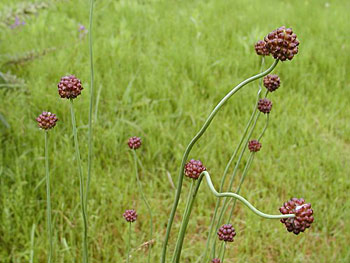Relatives
Allium macrostemon Bunge - Long-stamened onion.
Taxonomic position.
Family: Alliaceae J.Agardh, genus: Allium L.Synonyms.
Allium uratense Franch.Morphology and biology.
Perennial, herbaceous, bulbous plant. A single, globular bulb is covered with a blackish-brown, papery, skin. Stolons with 1-2 bulbils branch out of the bulb. The stem is 60-90 (up to 110) cm tall, smooth; 1/3 is covered with axils. Leaves are shorter than the stem, 2-6 mm wide, semi-cylindrical, grooved, with 3 prominent edges on the outside. The umbel is hemispheric or globular, polyanthous, dense, 3-4.5 cm in diameter. Inflorescence occurs more frequently with bulbils than without. Pedicels are thin, (2) 4-5 times longer than the perianth. Tepals are 3.5-5.0 mm long and 1.5-2.0 mm wide, pink with a darker vein, oblong-ovate, acute. Filaments are 1.5 times longer than the perianth, whole, awl-shaped. The style noticeably protrudes from the perianth. Blossoms in June/July; bears fruit in July. 2n=32.Distribution.
Russian Far East (Ussuri floristic region), Eastern Mongolia, Northern and Northeastern China, Korean Peninsula.Ecology.
Grows in meadows and arable fields, among shrubs along river valleys, and in oak woods.Utilization and economic value.
Used for food as a vegetable and as a source of vitamins. Bulbs are used by local population for pickling. Very high-yielding species. Threatened, ancient crop.References:
Brezhnev, D.D., Korovina, O.N. 1981. Wild relatives of cultivated plants in the USSR flora. Leningrad: Kolos, 375 p.Harkevich S.S., ed. 1988. Vascular plants of the Soviet Far East. V. 2. Leningrad: Nauka, p. 378-379.


